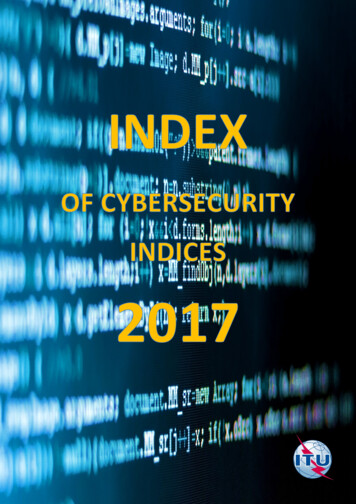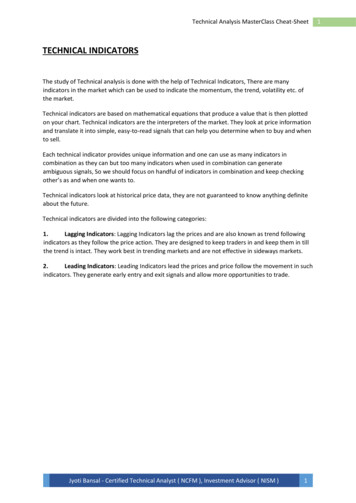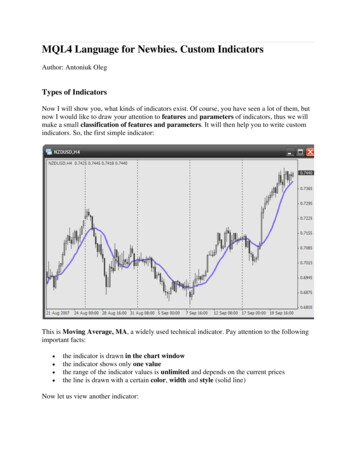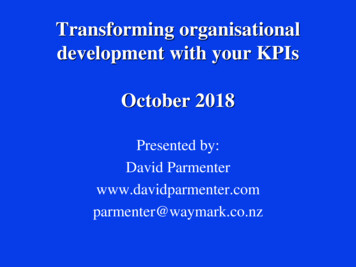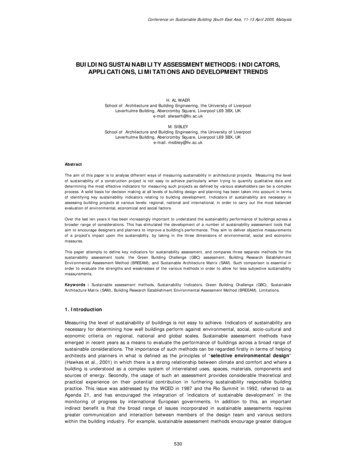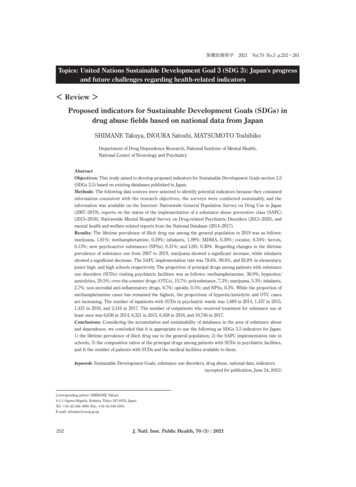
Transcription
保健医療科学2021Vol.70 No.3 p.252-261Topics: United Nations Sustainable Development Goal 3 (SDG 3): Japan's progressand future challenges regarding health-related indicators Review Proposed indicators for Sustainable Development Goals (SDGs) indrug abuse fields based on national data from JapanSHIMANE Takuya, INOURA Satoshi, MATSUMOTO ToshihikoDepartment of Drug Dependence Research, National Institute of Mental Health,National Center of Neurology and PsychiatryAbstractObjectives: This study aimed to develop proposed indicators for Sustainable Development Goals section 3.5(SDGs 3.5) based on existing databases published in Japan.Methods: The following data sources were selected to identify potential indicators because they containedinformation consistent with the research objectives, the surveys were conducted sustainably, and theinformation was available on the Internet: Nationwide General Population Survey on Drug Use in Japan(2007–2019), reports on the status of the implementation of a substance abuse preventive class (SAPC)(2015–2018), Nationwide Mental Hospital Survey on Drug-related Psychiatric Disorders (2012–2020), andmental health and welfare-related reports from the National Database (2014–2017).Results: The lifetime prevalence of illicit drug use among the general population in 2019 was as follows:marijuana, 1.81%; methamphetamine, 0.39%; inhalants, 1.09%; MDMA, 0.30%; cocaine, 0.34%; heroin,0.13%; new psychoactive substances (NPSs), 0.31%; and LSD, 0.30%. Regarding changes in the lifetimeprevalence of substance use from 2007 to 2019, marijuana showed a significant increase, while inhalantsshowed a significant decrease. The SAPC implementation rate was 78.6%, 90.6%, and 85.8% in elementary,junior high, and high schools respectively. The proportion of principal drugs among patients with substanceuse disorders (SUDs) visiting psychiatric facilities was as follows: methamphetamine, 36.0%; hypnotics/anxiolytics, 29.5%; over-the-counter drugs (OTCs), 15.7%; polysubstance, 7.3%; marijuana, 5.3%; inhalants,2.7%; non-steroidal anti-inflammatory drugs, 0.7%; opioids, 0.5%; and NPSs, 0.3%. While the proportion ofmethamphetamine cases has remained the highest, the proportions of hypnotic/anxiolytic and OTC casesare increasing. The number of inpatients with SUDs in psychiatric wards was 1,689 in 2014, 1,437 in 2015,1,431 in 2016, and 2,416 in 2017. The number of outpatients who received treatment for substance use atleast once was 6,636 in 2014, 6,321 in 2015, 6,458 in 2016, and 10,746 in 2017.Conclusions: Considering the accumulation and sustainability of databases in the area of substance abuseand dependence, we concluded that it is appropriate to use the following as SDGs 3.5 indicators for Japan:1) the lifetime prevalence of illicit drug use in the general population; 2) the SAPC implementation rate inschools; 3) the composition ratios of the principal drugs among patients with SUDs in psychiatric facilities,and 4) the number of patients with SUDs and the medical facilities available to them.keywords: Sustainable Development Goals, substance use disorders, drug abuse, national data, indicators(accepted for publication, June 24, 2021)Corresponding author: SHIMANE Takuya4-1-1 Ogawa-Higashi, Kodaira, Tokyo 187-8553, Japan.Tel: 81-42-346-1869 /Fax: 81-42-346-1954E-mail: shimane@ncnp.go.jp252J. Natl. Inst. Public Health, 70 (3) : 2021
Proposed indicators for Sustainable Development Goals (SDGs) in drug abuse fields based on national data from JapanI. IntroductionSustainable Development Goals (SDGs) comprise international goals for the achievement of a better and moresustainable world by 2030, as stated in the 2030 Agenda forSustainable Development, which was unanimously adoptedby member countries at the United Nations (UN) Summitin September 2015 as the successors of the Millennium Development Goals formulated in 2001. Health-sector targetswere included in Goal 3: ensure healthy lives and promotewell-being for all ages [1]. Furthermore, the target for substance abuse was set in “Goal 3.5: strengthen the prevention and treatment of substance abuse, including narcoticdrug abuse and harmful use of alcohol.” Global indicatorshave been set for each of the SDGs. In particular, “Indicator3.5.1: coverage of treatment interventions (pharmacological,psychosocial and rehabilitation and aftercare services) forsubstance use disorders (SUDs)” has been set for Target 3.5[2].Currently, the drug policy in Japan is based on the FifthFive-Year Strategy for Substance Abuse Prevention (FFstrategy) led by the Ministry of Health, Labor and Welfare(MHLW) [3]. The prevention of substance abuse amongyouth was emphasized in “Goal 1: prevention of drug abuseby raising the awareness of the whole nation about thenorms through publicity and awareness-raising, especiallyamong youth.” Specific measures included the enhancement of substance abuse preventive classes (SAPC) inschools and strengthening public relations and awarenessbased on scientific findings. Regarding treatment, “Goal 2:prevent reuse of drugs by providing appropriate treatmentand effective support for rehabilitation” emphasizes the importance of dealing with substance abusers. Specific measures include strengthening the medical provision system(e.g., treatments for SUDs) and guidance and support forrehabilitation by criminal justice agencies.Treatment interventions for patients using illegal drugs,such as methamphetamine, have focused on addressingchronic addictive psychoses such as hallucinations and delusions; however, the focus of treatment and support is nowon SUDs. For instance, the Serigaya Methamphetamine Relapse Prevention Program (SMARPP), a relapse preventionprogram for SUDs, was developed in 2006 [4][5]. SMARPP,a cognitive-behavioral therapy program based on the Matrixmodel [6], is highly rated as an intensive outpatient program for cocaine users in the United States (US) and hasbeen modified for methamphetamine users, who comprisethe core patient population of addiction clinical practice inJapan. Currently, the program is being disseminated to psychiatric facilities and mental health and welfare centers nationwide. Since 2016, SMARPP has been covered by healthinsurance as group therapy for relapse prevention.The number of patients eligible for treatment interventions in the community was calculated to determine thecoverage of treatment interventions for patients with SUDsas defined in Goal 3.5. However, the number of illegal drugusers (e.g., methamphetamine users) in Japan is small,rendering it difficult to estimate the number of potentialpatients with SUDs in the community. Furthermore, SDGsIndicator 3.5.1, which covers the area of substance abuse,states that it is an “indicator for which internationallyagreed definition nor computation method has not been released by United Nations so far” Therefore, indicator definitions and calculation methods remain to be determined. Inlight of these limitations, we aimed to propose a set of SDGindicators for Japan in the area of substance abuse, usingdata from nationwide surveys conducted over several years,as well as publicly available administrative information,such as the status of illicit drug use in the general population, the status of SAPC implementation in schools, and thestatus of treatment for SUDs in psychiatric facilities.II. MethodsThe following criteria for database selection were established: contained information consistent with the researchobjectives, ongoing surveys (i.e., sustainably conducted),and the information was available on the Internet. We alsodetermined the outcomes that could be used as proposedSDG indicators from each database. When necessary, inquiries were made to the research entities of the databasevia e-mails and phone calls. The following data sourceswere included in this study: Nationwide General PopulationSurvey on Drug Use in Japan (NGP survey) [7], reports onthe status of SAPC implementation [8], Nationwide MentalHospital Survey on Drug-related Psychiatric Disorders(NMH survey) [9], and mental health and welfare-relatedreports from the National Database (NDB) [10]. Each ofthese data sources is described in detail in the followingsections.1. NGP surveyNGP surveys have been conducted by the National Center of Neurology and Psychiatry (NCNP) every other yearsince 1995 to estimate the number of substance users inthe general population and to examine changes over time.The subjects comprised 7,000 randomly selected residentsaged 15–64 years. Information was collected using a self-administered questionnaire.The main outcome, and proposed SDG indicator, was theestimate (point estimate and 95% confidence interval [CI])of the lifetime prevalence of illicit drug use for eight sub-J. Natl. Inst. Public Health, 70 (3) : 2021253
SHIMANE Takuya, INOURA Satoshi, MATSUMOTO Toshihikostances: marijuana, methamphetamine, inhalants, MDMA,cocaine, heroin, new psychoactive substances (NPSs), andLSD. Additionally, the estimated past-year prevalence of illicit drug use was a sub-outcome. In this study, we referredto data from 2007 to 2019 for which estimates of the lifetime prevalence of illicit drug use were publicly available.The change in drug prevalence over time by survey yearwas determined based on an overlap in 95% CIs. In otherwords, the upper limit of the interval estimates of drug Ain year X was compared to the lower limit of the intervalestimate of drug A in year Y. If the lower limit in year Y washigher than the upper limit in year X, the lifetime prevalence of drug A was considered to have increased significantly from year X to year Y.drug was defined as “the drug of abuse that was considered to have the greatest impact on the clinical problem(e.g., psychosis or dependence) by the attending psychiatrist,” and the physicians who completed the questionnairewere asked to select one of the following drug categories:methamphetamine, inhalants, marijuana, cocaine, heroin,MDMA, hallucinogens other than MDMA, NPSs, hypnotics/anxiolytics, non-steroidal anti-inflammatory drugs(NSAIDs), opioids, over-the-counter drugs (OTCs; coughand cold medicines, analgesics, etc.), medications for attention-deficit hyperactivity disorder, others, and polysubstance. In this study, we referred to data from 2012 to 2020,for which data on patients with a history of substance usewithin the past year were publicly available.2. Status of the implementation of SAPCPreventive education on substance abuse for young people in Japan is provided consistently from elementary tohigh school through health and physical education. In addition to this standard curriculum, the FF strategy requiresall junior high schools (a three-year program for ages 12 to15 years) and high schools (a three-year program for ages15 to 18 years) to provide an SAPC at least once per yearwith an external expert, such as a police officer or pharmacist. Elementary schools (a six-year program for ages 6 to12 years) are also expected to host the event according tolocal circumstances.The Ministry of Education, Culture, Sports, Science andTechnology (MEXT) is responsible for surveying the statusof SAPC implementation at each school, which is reportedand published annually through the Board of Education ateach prefecture and government-designated city.The main outcome, and proposed SDG indicator, wasthe SAPC implementation rate, overall and by school type(elementary, junior high, or high school). In this study, wereferred to data from 2015 to 2018, which were publishedonline.4. NDB reportsThe NDB, established by the MHLW, contains information on medical receipts and specified medical examinationsand covers all medical receipts within the universal healthinsurance system in Japan. Using the NDB, the NCNPpublishes mental health and welfare-related reports on theresults of medical treatment for each disease in the regionthroughout the year, and the demographics of patients admitted and discharged from hospitals, as well as informationon medical centers for dementia diseases and ambulancetransport times.The main outcomes and proposed SDG indicators werethe number of inpatients with SUDs in psychiatric wardsnationwide, the number of outpatients who received treatment for substance use at least once, and the number ofoutpatients who received group therapy for relapse prevention. The sub-outcomes and proposed SDG indicators werethe number of hospitals with psychiatric wards that provided inpatient treatment for SUDs, medical facilities that provided outpatient treatment for SUDs, and medical facilitiesthat provided group therapy outpatient services for relapseprevention, covered by health insurance. In this study, wereferred to data from 2014 to 2017 that were published onthe Internet.This study used existing databases published on theInternet and did not obtain new information from subjects.Therefore, this study was not subject to ethical guidelinesfor medical research involving human subjects.3. NMH surveyNMH surveys, conducted by the NCNP every other yearsince 1987, cover “patients with drug-related psychiatricdisorders due to the use of psychoactive substances otherthan alcohol” who were either hospitalized or treated asoutpatients at psychiatric facilities with psychiatric wardsin Japan. Each physician at the surveyed facilities collectedclinical information (without personal information) by completing a questionnaire through the transcription of medicalrecords and interviews.The main outcome, and proposed SDG indicator, was theproportion of principal drugs in target patients who had ahistory of substance use within the past year. The principal254III. Results1. NGP surveyTable 1 shows the estimated lifetime prevalence of illicitdrug use in the general Japanese population aged 15–64years. The lifetime prevalence in 2019 was 1.81% for marijuana, 0.39% for methamphetamine, 1.09% for inhalants,J. Natl. Inst. Public Health, 70 (3) : 2021
Proposed indicators for Sustainable Development Goals (SDGs) in drug abuse fields based on national data from JapanTable 1 Estimated lifetime prevalence of illicit drug use in the general population aged 15 to 64 years (2007-2019) HeroinNPSLSD20070.84 (0.55-1.28)0.44 (0.24-0.81)2.03 (1.58-2.62)0.19 (0.08-0.47)0.13 (0.00-0.38)0.07 (0.00-0.27)‐‐20091.43 (1.02-1.99)0.34 (0.18-0.63)1.88 (1.43-2.47)0.22 (0.10-0.50)0.22 (0.09-0.57)N/A‐‐20111.21 (0.82-1.79)0.41 (0.22-0.75)1.57 (1.15-2.13)0.15 (0.06-0.35)0.08 (0.00-0.26)N/A‐‐20131.10 (0.75-1.60)0.53 (0.31-0.92)1.87 (1.39-2.51)0.27 (0.12-0.61)0.08 (0.00-0.34)0.07 (0.00-0.27)0.41 (0.23-0.73)‐20151.01 (0.68-1.48)0.53 (0.31-0.91)1.47 (1.07-2.02)0.13 (0.05-0.29)0.05 (0.05-0.31)0.07 (0.00-0.24)0.33 (0.17-0.63)‐20171.45 (0.85-2.43)0.54 (0.30-0.99)1.13 (0.78-1.63)0.16 (0.06-0.41)0.28 (0.11-0.72)N/A0.24 (0.09-0.64)‐20191.81 (1.40-2.35)0.39 (0.21-0.73)1.09 (0.80-1.48)0.30 (0.15-0.59)0.34 (0.17-0.67)0.13 (0.04-0.41)0.31 (0.15-0.61)0.30 (0.20-0.60)Source:National Center of Neurology and Psychiatry, Nationwide General Population Survey on Drug Use in Japan, https://www.ncnp.go.jp/nimh/yakubutsu/index.html( - ): Data not available; N/A: Not applicable; NPS: New psychoactive substancesPoint estimates and interval estimates (95% confidence intervals) are shown.SPSS complex samples were used for estimation and weighted in consideration of the sampling plan.NPSs have been included since 2013, and LSD since 2019.Table 2 Estimated past-year prevalence of illicit drug use in the general population aged 15 to 64 years (2007-2019) HeroinNPSLSD20070.06 (0.00-0.24)0.03 (0.00-0.25)N/A0.04 (0.00-0.26)0.05 (0.00-0.35)N/A‐‐20090.01 (0.00-0.09)N/AN/AN/AN/AN/A‐‐20110.05 (0.00-0.19)N/AN/AN/AN/AN/A‐‐2013N/AN/AN/A0.04 (0.00-0.31)N/AN/A0.15 (0.06-0.39)‐20150.04 (0.00-0.15)N/A0.04 (0.00-0.18)N/AN/AN/AN/A‐20170.10 (0.00-0.74)N/A0.10 (0.00-0.30)N/AN/AN/AN/A‐20190.10 (0.05-0.24)0.04 (0.00-0.17)0.11 (0.00-0.38)0.04 (0.01-0.09)0.04 (0.01-0.09)0.04 (0.00-0.16)0.04 (0.01-0.09)0.04 (0.01-0.09)Source:National Center of Neurology and Psychiatry, Nationwide General Population Survey on Drug Use in Japan, https://www.ncnp.go.jp/nimh/yakubutsu/index.html( - ): Data not available; N/A: Not applicable; NPS: New psychoactive substancesPoint estimates and interval estimates (95% confidence intervals) are shown.SPSS complex samples were used for estimation and weighted in consideration of the sampling plan.NPSs have been included since 2013, and LSD since 2019.Table eHeroinNPSLSDInternational comparisons in the lifetime prevalence of illegal drug use in the general population (%)Japan201915-641.81 (1.40-2.35)0.39 (0.21-0.73)1.09 (0.80-1.48)0.30 (0.15-0.59)0.34 (0.17-0.67)0.13 (0.04-0.41)0.31 (0.15-0.61)0.30 (0.20-0.60)US201918 or older46.25.89.17.315.12.110EU202015-6427.23.7 4.15.4-Canada201715 or older46.6 (44.3-48.8)3.7 (2.8-4.6)7.6 (6.2-9.0)10.4 (9.0-11.9)0.7 (0.3-1.1)14.3 (12.6-15.9 ) Thailand201912-652.55 (2.34-2.79)2.34 (2.14-2.57)0.35 (0.27-0.46)0.23 (0.16-0.32)0.12 (0.07-0.20)0.25 (0.18-0.37)-All data represent estimates prevalence (data in Japan, Canada, and Thailand indicate 95% confidence interval).( - ): Data not available : Data for hallucinogens : Data for amphetamine NPS: New psychoactive substanceJapan: Nationwide General Population Survey on Drug Use in JapanUS: National Survey on Drug Use and Health (NSDUH)EU: European Monitoring Center for Drug and Drug Addiction (EMCDDA)Canada: Canadian Tobacco, Alcohol and Drugs Survey (CTADS)Thailand: Survey on the quality of living and size estimation on substance use0.30% for MDMA, 0.34% for cocaine, 0.13% for heroin,0.31% for NPS, and 0.30% for LSD. Among the eight illegaldrugs, marijuana had the highest lifetime prevalence andincreased significantly from 2007 to 2019. In contrast, thelifetime prevalence of inhalants decreased significantly from2007 to 2019. Other drugs remained unchanged, with overlapping 95% CIs. Regarding the past-year prevalence, theactual number of drug users was very small, and there wereno responses for some questions, making it difficult to esti-mate the number of potential drug users in the community(Table 2).Table 3 shows an international comparison of the lifetimeprevalence of illegal drug use in the general population. Thelifetime prevalence of illicit drug use in Japan was significantly lower than that in the US, the European Union, andCanada. Additionally, the lifetime prevalence of marijuana,methamphetamine, and heroin was lower in Japan than inThailand, which is in the same Asian region as Japan, whileJ. Natl. Inst. Public Health, 70 (3) : 2021255
SHIMANE Takuya, INOURA Satoshi, MATSUMOTO Toshihikothe lifetime prevalence of inhalants, MDMA, and cocainewas higher in Japan than in Thailand.phetamine, 36.0%; hypnotics/anxiolytics, 29.5%; OTCs,15.7%; polysubstance, 7.3%; marijuana, 5.3%; inhalants,2.7%; NSAIDs, 0.7%; opioids, 0.5%; and NPSs, 0.3%. Between 2012 and 2020, methamphetamine cases comprisedthe highest proportion, and the proportion of hypnotics/anxiolytic and OTC cases increased. NPSs have been decliningrapidly since 2016.2. Status of SAPC implementationTable 4 shows the status of SAPC implementation according to school type. In 2018, the SAPC implementationrates by school type were as follows: elementary schools,78.6%; junior high schools, 90.6%; and high schools, 85.8%.The SAPC implementation rate across all school types remained unchanged over 2015 (81.0%), 2016 (82.5%), 2017(83.5%), and 2018 (83.2%).4. Mental health and welfare-related reports from theNDBTable 6 shows the number of patients with SUDs referredto the NDB. The number of inpatients with SUDs in psychiatric wards was 1,689, 1,437, 1,431, and 2,416 in 2014, 2015,2016, and 2017 respectively. The number of outpatientswho received treatment for substance use at least once was6,636, 6,321, 6,458, and 10,746 in 2014, 2015, 2016, and2017 respectively. The number of outpatients who received3. NMH surveyTable 5 presents the ratios of the principal drugs in patients with drug-related psychiatric disorders due to the useof psychoactive substances other than alcohol in psychiatricfacilities nationwide in the 2020 NMH survey: methamTable 4Status of the implementation of a substance abuse preventive class by school type (2015-2018) (%)YearAll type of schoolsElementary schoolsJunior high schoolsHigh 783.579.191.086.4201883.278.690.685.8Source: Ministry of Education, Culture, Sports, Science and Technology, Bureau of Elementary and Secondary Education, Health Education and Shokuiku Division, Yakubutu-ranyou-boushi-kyoushitsu ni tsuite, https://www.mext.go.jp/a menu/kenko/hoken/1297198.htmThe Fifth Five-Year Strategy for Substance Abuse Prevention states that substance abuse preventive class (SAPC) should be included inschool health plans and held at least once a year in all junior high and high schools, and also in elementary schools according to local circumstances.Elementary school in Japan is a six-year program (for ages 6 to 12 years), junior high school is a three-year program (for ages 12 to 15years), and high school is a three-year program (for ages 15 to 18 years).Table 5Ratios of principal drugs among patients with drug-related psychiatric disorders due to the use of psychoactive substances other than alcohol in psychiatric facilities nationwide (2012-2020) inMDMAHallucinogen other than MDMANPSHypnotic, anxiolyticNSAIDsOpioidOTCADHD MedicationsOthersPolysubstance2012(n .32014(n 04.92016(n 7.32018(n 5.92020(n 77.3Source:National Center of Neurology and Psychiatry, Nationwide Mental Hospital Survey on Drug-related Psychiatric Disorders, e principal drug was defined as "the drug that seems to be most clinically relevant to the current psychiatric symptoms" and the physicians who completed the questionnaire were asked to select one of the following drug categories: methamphetamine, inhalant, marijuana,cocaine, heroin, MDMA, hallucinogens other than MDMA, new psychoactive substance (NPS), hypnotic/anxiolytic, non-steroidal anti-inflammatory drugs (NSAIDs), opioid, over-the-counter drug (OTC), medication for attention-deficit hyperactivity disorder (ADHD), others,and polysubstance.Only cases with a history of drug use within the past year were selected.256J. Natl. Inst. Public Health, 70 (3) : 2021
Proposed indicators for Sustainable Development Goals (SDGs) in drug abuse fields based on national data from JapanTable 6Number of patients with SUDs referred to the NDB (2014-2017)YearNo. of inpatients with SUDs in psychiatric wardsNo. of outpatients who received treatment for substance use (at least once)No. of outpatients who received treatment for substance use (two or more times)No. of outpatients who received group therapy for relapse . Number; ( - ): Data not available; SUD: substance use disorder; NDB, National DatabaseGroup therapy for relapse prevention has been covered by health insurance since 2016.Table 7The number of medical facilities treating patients with SUDs referred to the NDB (2014-2017)YearNo. of hospitals with psychiatric wards that provided inpatient treatment for SUDsNo. of medical facilities that provided outpatient treatment for SUDsNo. of medical facilities that provided group therapy outpatient services for relapseprevention, covered by health 09-7112,486‐‐511No. Number; ( - ): Data not available; SUD: substance use disorder; NDB, National Database※Group therapy for relapse prevention has been covered by health insurance since 2016.group therapy for relapse prevention was 57 in 2016 and142 in 2017.Table 7 shows the number of medical facilities that treated patients with SUDs referred to the NDB. The number ofhospitals with psychiatric wards providing inpatient treatment for SUDs was 494, 503, 487, and 709–711 in 2014,2015, 2016, and 2017. The number of medical facilities thatprovided group therapy outpatient services for relapse prevention, covered by health insurance, was 5 in 2016 and 11in 2017.IV. Discussion1. Lifetime prevalence of illicit drug use in the general populationWe propose the lifetime prevalence of illicit drug use inthe general population nationwide as one SDG 3.5.1 indicator. The source database for GPS surveys is based on publicresearch-funded projects rather than government statistics.GPS surveys have been conducted biennially for more thantwenty years (since the 1990s). Therefore, the sustainability of the data is expected to be high in the future. However,the lifetime prevalence of illegal drug use as a proposed indicator suffers from a limitation: the data do not necessarilyreflect the current prevalence of illicit drug use because itincludes past experiences. The data would be more reflective of the current state of illicit drug use if the most recentuse, such as the past-year prevalence of illicit drug use, wasused as an indicator. In Japan, where the number of illicitdrug users is lower than that in other countries, the pastyear experience rate is significantly lower, or there areno applicable persons. Given these circumstances, we arecompelled to recommend the lifetime prevalence of illicitdrug use as an indicator. It should also be noted that, in Japan, as the use of illegal drugs (e.g., methamphetamine orcocaine) is strictly punishable by law, and questions aboutone’s experience with using illegal drugs, even if it is a pastexperience, may cause a certain amount of reporting bias.Changes from 2007 to 2019 reflect a significant decreasein inhalants and a significant increase in marijuana. Thisresult is similar to drug crime trends. For example, according to a White Paper on Crime published by the Ministry ofJustice [11], the number of people arrested for violating thePoisonous and Deleterious Substances Control Act, whichregulates the abuse of inhalants, continued to exceed 20,000per year in the 1980s but began to decline in the 1990s, andthere were only 177 arrests in 2019. Contrastingly, over3,000 people were arrested for marijuana use in 2009, butthe number has been subsequently declining. However,since 2014, the number has been rising again, and the number of arrests in 2019 was 4,570 (the highest number yet).Most of the arrests for the violation of the Cannabis ControlAct involved young people in their 20s and 30s. The movement to legalize marijuana in other countries may have hada considerable influence on the increase in marijuana use inJapan. For example, according to a National Police Agencysurvey of arrests for violations of the Cannabis Control Act(the offense was simple possession), the most commonresponse was “because there are countries in which marijuana is undergoing legalization” as a reason for ignoringthe risk of marijuana [12]. It has been reported that thereis a widespread affirmation of marijuana use among youngpeople; especially those in their 20s and 30s, who state that“using marijuana is a personal choice” and “a little bit isokay” [7].2. Implementation rate of SAPC in schoolsAccording to the MEXT database, all school types hada high SAPC implementation rate (80%). Furthermore,our findings show that the SAPC implementation rate wasJ. Natl. Inst. Public Health, 70 (3) : 2021257
SHIMANE Takuya, INOURA Satoshi, MATSUMOTO Toshihikohigher in junior high and high schools than in elementaryschools. The higher percentage in junior high and highschools is probably because Japan’s drug policy, the FFstrategy, clearly states that “SAPC should be included inschool health plans and held at least once a year in all juniorhigh and high schools.”This proposed indicator would fall under “strengthen theprevention of substance abuse” in the section on Indicator3.5. The database that served as the source of informationis published on the Internet by MEXT, and the indicatorsare considered to be highly sustainable. However, there isa limitation in that only quantitative data, that is, the SAPCimplementation rate can be ascertained. Therefore, it isnot possible to ascertain the qualitative aspects of the topics covered in the SAPC and the types of addictive drugshandled. Furthermore, the style of education and messageto the youth may differ depending on the job title of theoutside instructor in charge of the SAPC. For example, ifa police officer is leading the class, they are more likely toemphasize the criminality of illegal drugs. If a pharmacistis leading the class, they are more likely to emphasize thepharmacological and health effects of addictive drugs. TheMEXT database also provides information on the job titlesof the instructors who prepared the SAPC [8].3. Composition ratios of principal drugs among persons with SUDs in psychiatric facilitiesWe propose the composition ratios of principal drugsrelated to SUDs other than alcohol in psychiatric facilitiesnationwide as one of the indicators. Limiting the indicatorto cases with a history of substance use within the pastyear would be more reflective of the current status of theSUD epidemic. In Australia [13], the composition ratios ofprincipal drugs have been used as an indicator for SDGs 3.5,and it is considered to be an indicator that can be comparedinternationally.The highest proportion of cases in Japanese psychiatric facilities comprised methamphetamine users, whichhad a higher age range than that of other drug users. Forexample, patients in their 40s, 30s, and 20s accounted forthe high
substance use disorders (SUDs)" has been set for Target 3.5 [2]. Currently, the drug policy in Japan is based on the Fifth Five-Year Strategy for Substance Abuse Prevention (FF strategy) led by the Ministry of Health, Labor and Welfare (MHLW) [3]. The prevention of substance abuse among youth was emphasized in "Goal 1: prevention of drug abuse

